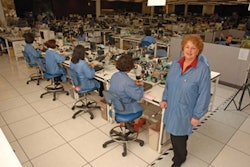
The end of a recession might seem like a strange time to be considering fundamental transformations in how you manage your supply chain. But with companies gearing up for growth ahead, what better time for supply chain organizations to shift gears, too, and assess whether the supply chain that brought them into the recession is best for leading them forward into the New Year and beyond. After all, as Elliott M. Estes, the late former president of General Motors, said almost 35 years ago, "When something has been done a particular way for five years, it is a pretty good sign, in these changing times, that it is being done the wrong way."
That quote popped up during a presentation by Andrew J. Houser and Robert A. Rudzki at the recent Southwest Supply Management Conference, held in Dallas early in October by the Southwest Forum of the Institute for Supply Management (www.ismswscf.org). Houser, vice president of supply chain management at Commercial Metals Company (CMC, www.commercialmetals.com), joined Rudzki, president of consulting firm Greybeard Advisors (www.greybeardadvisors.com), to address the topic of best practices and key success factors in supply management transformation. The Estes quote was the lead into their presentation and helped address the question of "why transform now?"
Rudzki, a recent Pro to Know, is no stranger to transformation, having led strategic initiatives as a former Fortune 500 chief procurement officer before moving to the consulting side. He also is a longtime evangelist for the strategic value that Supply Chain can bring to the table in the enterprise. Houser, too, brings significant transformation experience to the table, having previously served as executive director for supply chain management with EDS. Houser joined CMC last year just as the company was beginning to form a new, centralized supply chain organization, and he worked with Greybeard as part of the consulting firm's engagement with CMC to help the company build its supply management processes and team.
Highlighting the potential return on investment in transformation, Rudzki noted that by achieving "world-class" supply management, companies have been shown to achieve total cost reductions of 2-10 percent for direct spend and 10-40 percent for indirect spend. But the real bottom line impact can be even more significant based on metrics like return on invested capital (ROIC) and cash flow. "Supply management can drive improvements in ROIC and cash flow in many specific ways: revenue enhancements, cost reductions, working capital improvements and better capital spending," Rudzki says. "By working on all areas simultaneously, there can be a powerful compounding effect."
The "transformation roadmap" begins with an objective assessment of the "as is" state of the company's supply management and procurement performance against "best-in-class" organizations not only within the company's own industry but across all sectors. That evaluation serves as the basis for a gap analysis to identify and quantify opportunities, and to assess which specific initiatives to pursue first, second and so on, in a way that builds results over time. "This is part art and part science," Rudzki says. "Done poorly, it can be the reason for 'evaporating results.' Done well, the roadmap will create sustainable results and momentum, and build organizational capabilities that drive superior performance."
In terms of success factors, Houser says: "You have to have true executive sponsorship of the initiative, and it has to be viewed as strategic. That means resources, endorsement and involvement." Houser notes that at too many companies, supply chain continues to be viewed as a back office, transactionally focused function. "But," he adds, "it's becoming more and more prevalent, especially in these times of economic downturn, that companies are looking not simply to drive cost out of their business, but to be more agile and efficient, and to put a supply chain in place that can quickly adapt to a market in which no one knows what's going to happen next."
You can read more about CMC's transformation journey at www.SDCExec.com/CMCtransforms. In the meantime, how has your supply chain changed during the course of the recession? If you have had an interesting transformation journey, please share your story with the community by writing me at [email protected]. I'll look forward to hearing from you.
— Andrew K. Reese
Editor, Supply & Demand Chain Executive
That quote popped up during a presentation by Andrew J. Houser and Robert A. Rudzki at the recent Southwest Supply Management Conference, held in Dallas early in October by the Southwest Forum of the Institute for Supply Management (www.ismswscf.org). Houser, vice president of supply chain management at Commercial Metals Company (CMC, www.commercialmetals.com), joined Rudzki, president of consulting firm Greybeard Advisors (www.greybeardadvisors.com), to address the topic of best practices and key success factors in supply management transformation. The Estes quote was the lead into their presentation and helped address the question of "why transform now?"
Rudzki, a recent Pro to Know, is no stranger to transformation, having led strategic initiatives as a former Fortune 500 chief procurement officer before moving to the consulting side. He also is a longtime evangelist for the strategic value that Supply Chain can bring to the table in the enterprise. Houser, too, brings significant transformation experience to the table, having previously served as executive director for supply chain management with EDS. Houser joined CMC last year just as the company was beginning to form a new, centralized supply chain organization, and he worked with Greybeard as part of the consulting firm's engagement with CMC to help the company build its supply management processes and team.
Highlighting the potential return on investment in transformation, Rudzki noted that by achieving "world-class" supply management, companies have been shown to achieve total cost reductions of 2-10 percent for direct spend and 10-40 percent for indirect spend. But the real bottom line impact can be even more significant based on metrics like return on invested capital (ROIC) and cash flow. "Supply management can drive improvements in ROIC and cash flow in many specific ways: revenue enhancements, cost reductions, working capital improvements and better capital spending," Rudzki says. "By working on all areas simultaneously, there can be a powerful compounding effect."
The "transformation roadmap" begins with an objective assessment of the "as is" state of the company's supply management and procurement performance against "best-in-class" organizations not only within the company's own industry but across all sectors. That evaluation serves as the basis for a gap analysis to identify and quantify opportunities, and to assess which specific initiatives to pursue first, second and so on, in a way that builds results over time. "This is part art and part science," Rudzki says. "Done poorly, it can be the reason for 'evaporating results.' Done well, the roadmap will create sustainable results and momentum, and build organizational capabilities that drive superior performance."
In terms of success factors, Houser says: "You have to have true executive sponsorship of the initiative, and it has to be viewed as strategic. That means resources, endorsement and involvement." Houser notes that at too many companies, supply chain continues to be viewed as a back office, transactionally focused function. "But," he adds, "it's becoming more and more prevalent, especially in these times of economic downturn, that companies are looking not simply to drive cost out of their business, but to be more agile and efficient, and to put a supply chain in place that can quickly adapt to a market in which no one knows what's going to happen next."
You can read more about CMC's transformation journey at www.SDCExec.com/CMCtransforms. In the meantime, how has your supply chain changed during the course of the recession? If you have had an interesting transformation journey, please share your story with the community by writing me at [email protected]. I'll look forward to hearing from you.
— Andrew K. Reese
Editor, Supply & Demand Chain Executive



















